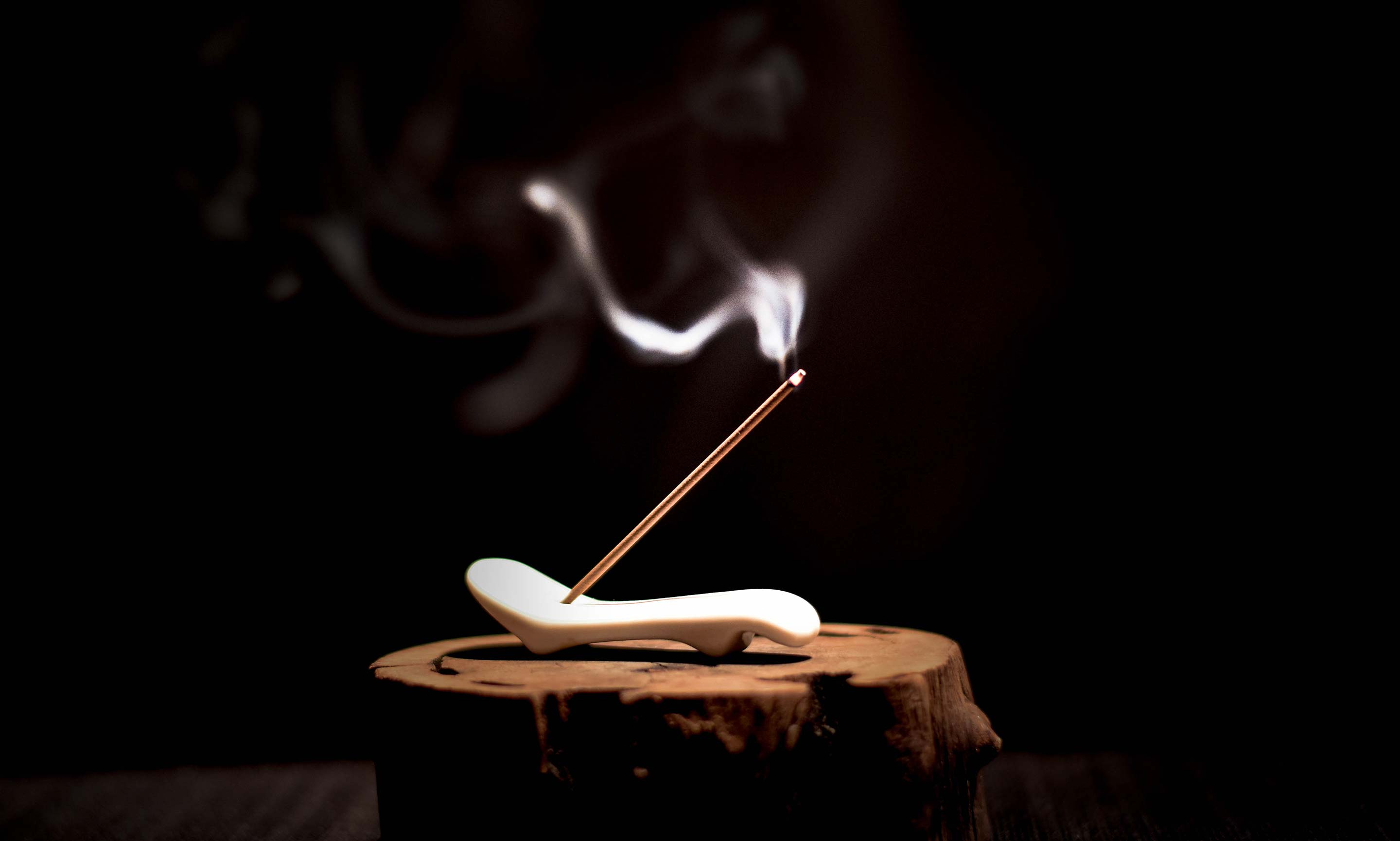We fell in love with tea years ago for the sense of peace, well-being, and clarity that the ritual of preparing tea inspires. The tea we love grows in some of the most beautiful places on earth. It is tended by families who own their land and care about what they do. It is finished by hand to capture and evoke that sense of nature and peace with each sip. Our friend, teacher and farmer partner Li Xiangxi puts it best, “Tea is a facilitator, when prepared with intentionality, it puts the tasters in the mindset to reflect, contemplate and discuss.”
Tea has been an integral part of Song Dynasty culture as an inspirational vehicle for writing poetry and painting. It has been a necessary part of the Buddhist meditation ritual.
This year we had the chance to discover an even deeper side to tea as a ritual. We had the privilege to attend Li Xiangxi’s school of Taoist Wuyi Tea Ceremony, and there, she introduced us to burning incense while preparing tea.

 Click to watch
Click to watch
Incense culture flourished alongside tea culture in the Song Dynasty. It was used to create a sense of space and environment in the scholarly studio, and to mark the passage of time. Each incense stick burns for a set amount of time, so lighting one was an easy way to ensure that enough time was devoted to tea tasting, or study.
Incense was and still is just as critical to both Buddhism and Taoism. Incense is lit in temples as an act of prayer and as an offering. Lighting and placing incense is still a way for modern Buddhists and Taoists to feel connected to something greater than the everyday world.
The religious and scholarly roots of incense culture make incense an indispensable complement to the modern tea ceremony. Lighting incense is a reminder to enjoy time with purpose and mindfulness – something we need now these days more than ever. Incense also offers a connection to the idea of ritual, an evocation of nature and a celebration of our connection to history. If we take the time to set out our tea ware and bring out our fine tea, incense helps us mark the tasting as a ritual to truly enjoy.
After studying tea and incense with Li Xiangxi, we decided to take it to the next level and study incense formally at Da Xin Tang’s accredited school of incense culture in Xiamen.
Da Xin Tang was founded in 1916 in Taiwan as Bai Nian Chen, and has since branched out to teaching incense culture and sharing their incense in mainland China.
We got to take classes from Da Xin Tang’s president Mei Haixia, who inspired us to to share incense on a wider scale as a part of tea ceremony. In her opinion, incense is just as important to preparing tea as your teapot.
Chinese Incense can be roughly divided into Medicinal Blends, Sandalwood and Aloeswood. Medicinal blends are inspired by Shen Nong’s encyclopedia of herbal medicine. They are created for treating specific health or spiritual issues, and are not specifically recommended for burning during tea ceremony.
High quality sandalwood incense is made from the resin-rich heartwood of mature sandalwood trees. Sandalwood is by far the most common incense burned in religious ceremony in temples and is often used for offerinsg at Buddhist and Taoist shrines. It is powerful and commanding, capable of filling a large space. Sandalwood is also much more plentiful than aloeswood, making it a very affordable way to set the mood in a space and create a higher sense of ritual and intent in brewing tea.
Sandalwood is piney, foresty and crisp. It goes best with full bodied intense teas with gripping texture and dark aftertaste such as Wuyi oolong, Zheng Shan Xiao Zhong, and Shu Pu’er. It works particularly well in public spaces and for larger gatherings.
Aloeswood is incense at its highest level. Aloeswood is an beautiful intersection of chance and terroir, produced by harvesting the resin from aloeswood trees whose bark is damaged, exposing the tree to a very specific fungus. The tree’s natural immune response produces this highly aromatic compound.
Aloeswood is sought after all over the world for mediation, for its potential health benefits in Traditional Chinese Medicine, and for being one of the most incredible smells out there. It deeply evokes a sense of place and is very complex and multifaceted owing to the terroir where the trees grow.
So what makes good aloeswood?
1. The type of tree needs to be the aloeswood tree, already a rare commodity due to overharvesting.
2. The age of the tree (at least 40 years). Young trees cannot produce the same depth of aroma, so there is no way to rush the process to keep up with market demand.
3. The tree injury. Bark has to be scratched or damaged to expose the aloeswood tree to the possibility for fungal growth. The highest quality aloeswood is harvested from trees that naturally sustained injury.
4. The infection. A very specific fungus has to grow and provoke the trees immune system for aromatic resin to be produced.
This set of circumstances is very rare. The tree only grows in hot humid regions above 400 meters sea level. The very best aloeswood is wild-harvested from a fallen aloeswood tree over 40 years of age. The best aloeswood is pure, rich and lingers on the palate and in the chest just like the finest teas. It is immediately evocative of place, being much richer and more complex than sandalwood.
On the more affordable end of aloeswood are sticks made from ground wood. These have aloeswood resin which produces a rich sweet and evocative aroma but is punctuated with a foresty smoke note from the wood pressed into the incense. This aloeswood is best with Wuyi oolongs, and black teas
Finer aloeswood has a higher percentage of resin to wood and sources from older trees. This aloeswood is thick, rich sweet and slightly salty. This aloeswood is best with sheng pu’er, jin jun mei and white tea.
So what benefit is there to adding incense to your daily tea?
Incense enhances the flavor of tea. It can provide a flavor counterpoint for tea and can reveal new and interesting ways to look at old favorites. Beyond aesthetics, lighting incense can help to creates the sense of a safe, purposeful, ritual space. Lighting fine incense fills a room with aroma, which is a powerful conscious and subconscious indicator.
In this way, incense can make a tasting instantly feel special. Taking the time to light a stick or coil of incense marks a moment in time as special and worth enjoying. This simple act can help you pay more attention to your tea and make the tea better in the process.
Incense also marks time in a meaningful way. Incense as hourglass was one of its earliest uses. In this way, lighting incense marks and sets out a period of time devoted study and practice. When paired with tea, a stick or coil of incense marks the amount of time you want to spend savoring a tea with purpose and with mindfulness. This gives you breathing room to devote your attention to something fully.
Beyond all of this, incense is also a historical connection to the past. Incense has been enjoyed for hundreds of generations, nearly unchanged. Lighting a stick of aloeswood today is the same experience that an early Song scholar or Buddhist monk would have had hundreds of year ago.
Finally, this the practice of incense allows us to enjoy an expression of terroir outside of tea. We love tea for its connection to place. It is joyful to find another culture in incense that so strongly evokes place through aroma. It can transport you to a forest, a mountain or a garden in a moment.


 How To
How To Myths & Legends
Myths & Legends Travelogue
Travelogue Tasting Journal
Tasting Journal Talking Shop
Talking Shop Tea 101
Tea 101 Watch
Watch Teaware
Teaware News
News













Leave a Reply
Wow!! I really love this kind of video. I would pay to sit in on classes like this, I wish I was in china. I cant hear enough of stuff like this.
So glad you enjoyed the video!! As for sitting in on a class.. :) We were lucky enough to film a few different lectures from Li Xiangxi. We'll continue working on translations over the next few months, and keep posting them whenever we can. Li Xiangxi is an excellent teacher, and one of our favorite people to stay up late with talking about tea, philosophy, and everything in between.
Where can I find the box of incense with the white holder you have in the second picture?
Great question! It looks like that is the Cloud Song Aloeswood mini-stick set:
http://verdanttea.com/teas/da-xin-tang-aloeswood-cloud-song-blend-incense-mini-stick-set/
The box includes two tubes of small format incense (50 sticks in each tube; each stick lasts about 15 minutes once lit), as well as a small white porcelain incense holder. I love lighting this one before starting a tea brewing session as a way to get into the right frame of mind! I can light a stick while I boil the water and gather all of my teaware together, and the mini sticks just help set the mood in the room without continuing for a long time after I start brewing my tea.